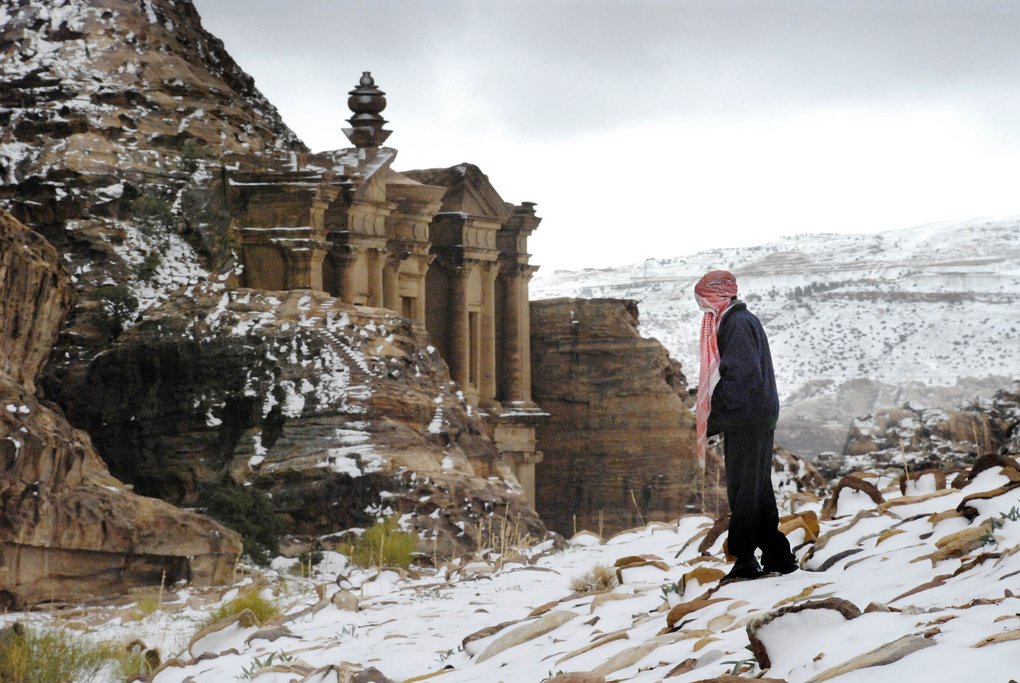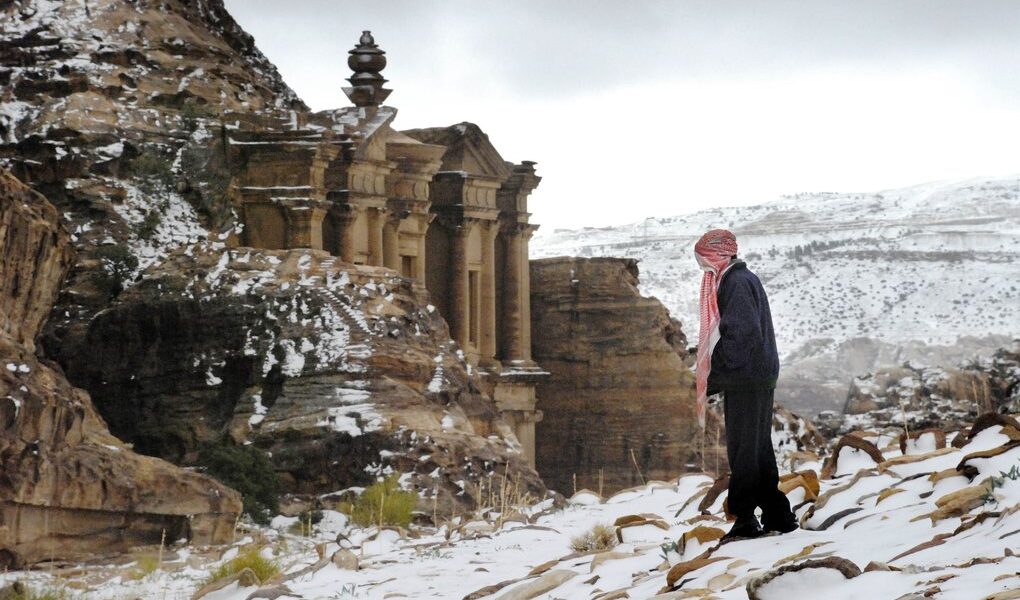
For a tourist-free experience in Petra, button-up and visit in January. Petra is in the midst of its cold, somewhat wet—and occasionally snowy—winter. But you can explore Petra without the crowds, rainy days are relatively few, and the infrequent and short-lived snows add a dramatic element.
## Weather Considerations for Visiting Petra in January
Preparing for a trip to Petra in January requires careful consideration of the weather conditions. Despite its location in the Middle East, Petra experiences surprisingly cold temperatures during the mid-winter month of January. Visitors should not underestimate the need for ample warm clothing. The average temperature in Petra during this time is a rather chilly 47°F (8°C). However, many days can be significantly colder than this average, and you can almost certainly expect frost overnight. In fact, snowfall is not unheard of in Petra during January, adding an unexpected dimension to the desert landscape. The coldest day of the year typically falls on January 21st, with average lows reaching a freezing 32°F (0°C) and average highs struggling to climb above 50°F (10°C).
January is also statistically the wettest month in Petra, accounting for almost one-quarter of the site’s annual rainfall. While this may sound daunting, the silver lining is that, on average, rain falls on only about five days throughout the entire month. To ensure a comfortable and enjoyable experience, it is essential to pack appropriate raingear, including a waterproof jacket and umbrella, alongside your collection of warm clothing. Sturdy walking shoes or hiking boots are also a must, given the likely amount of exploring you will be undertaking on foot. Dressing in layers is highly recommended, as this will allow you to easily adjust your clothing to accommodate fluctuating temperatures and activity levels throughout the day.
It’s crucially important to be mindful of the potential for sudden and torrential downpours. Extreme caution is strongly advised when navigating the narrow defiles and even the broader canyons of Petra, as these areas are susceptible to potentially deadly flash floods. These dramatic channels were, in fact, carved out over countless years by the very same type of powerful torrents. The iconic Siq, the main entrance to Petra, can transform into a raging riverbed during periods of heavy rainfall. Furthermore, the stones underfoot become exceptionally slippery when wet, posing a significant safety hazard. Be aware that the entire Petra site may be subject to closure during periods of heavy rain to ensure the safety of visitors. Therefore, it is always best to check weather updates frequently.
## Crowd Levels and Travel Costs
One of the compelling advantages of visiting Petra in January is the absence of large crowds. While Petra holds a unique allure year-round, the vast majority of tourists tend to avoid visiting during the colder winter months. In fact, only June and July, the peak of the sweltering summer season, see even lower visitor numbers than January. This translates into a much more personal and intimate experience, allowing you to fully appreciate the grandeur and history of Petra without the jostling and noise associated with peak season travel. The reduced demand also impacts airfare and accommodation costs, resulting in significantly lower prices. You may even be able to find excellent last-minute bargains at the various hotels in Wadi Musa and on tour excursions departing from there.
## Exploring the Wonders of Petra
The Petra Archaeological Park (PAP) encompasses a sprawling area of approximately 100 square miles (264 square kilometers) and offers a diverse range of experiences beyond simply visiting the renowned ancient ruins. The park is situated on a high plateau above Wadi Musa, known as the Valley of Moses, and boasts a breathtaking desert landscape that is well worth exploring.
Often overlooked, Little Petra, officially known as Siq Al-Barid, is a captivating site located just 3 miles (5 kilometers) north of Petra. This less-frequented “Mini Me” version of the main site offers a similar experience, with its own narrow Siq (a narrow slot canyon) leading to rock-wall temples and tombs. Notably, Little Petra also features a fascinating Nabataean irrigation system that once sustained the ancient vineyards, the remnants of which can still be seen on frescoes adorning the walls. In January, you may find yourself enjoying the rare opportunity to explore Little Petra almost entirely alone.
For active travelers seeking to combat the January chill, hiking the numerous trails that crisscross the Petra Archaeological Park is an excellent choice. Lace up your hiking boots and embark on the 8-mile (13-kilometer) desert trail that connects Little Petra to Petra. This moderately challenging hike provides a satisfying workout as it gradually ascends Jebel al-Deir before descending to The Monastery and ultimately leading you into Petra through a less-traveled “back door.”
In the evenings, escape the cold by seeking out a warm and inviting atmosphere at Petra Kitchen, located in Wadi Musa. The passionate local chefs at Petra Kitchen are eager to share their culinary expertise and love of Jordanian cuisine through nightly cooking classes. For a more immersive experience, consider enrolling in a multi-night cooking course that includes visits to local markets to source fresh ingredients, offering a truly comprehensive farm-to-table experience. Naturally, you will have the pleasure of savoring the fruits of your labor at the end of each cooking session. Petra Kitchen is a fantastic option when the winter weather is less than ideal. And for a truly authentic experience, consider trying the sheesha pipe after your meal!
B-1473

